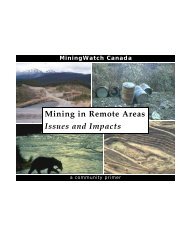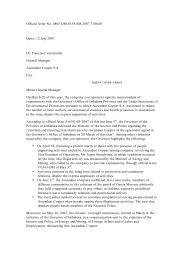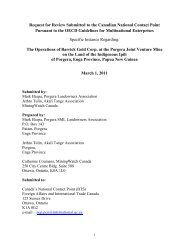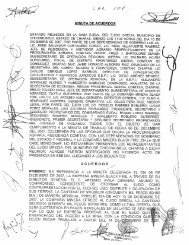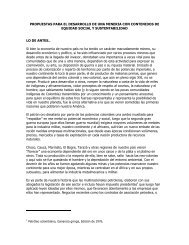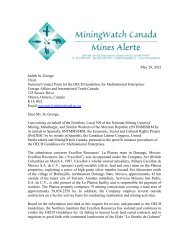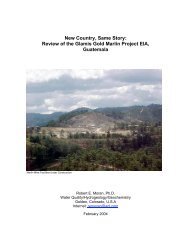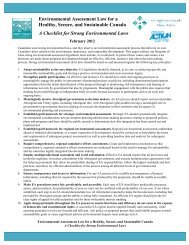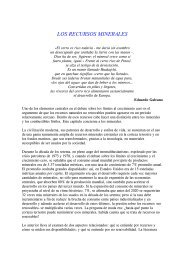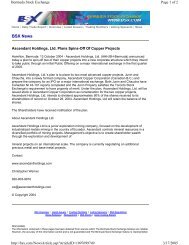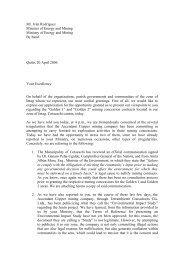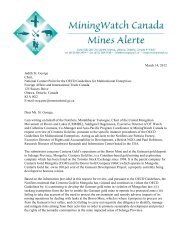Environmental Aspects of Phosphate and Potash Mining
Environmental Aspects of Phosphate and Potash Mining
Environmental Aspects of Phosphate and Potash Mining
- No tags were found...
You also want an ePaper? Increase the reach of your titles
YUMPU automatically turns print PDFs into web optimized ePapers that Google loves.
<strong>Environmental</strong> <strong>Aspects</strong> <strong>of</strong> <strong>Phosphate</strong> <strong>and</strong> <strong>Potash</strong> <strong>Mining</strong>Water Management <strong>and</strong> TreatmentThe Foskor Ltd. operation at Phalaborwa is located inthe semi-arid northeast <strong>of</strong> South Africa, adjacent to theSelati River <strong>and</strong> upstream from the Kruger NationalPark.The processing operation uses 250 million litres <strong>of</strong>water per day, the majority <strong>of</strong> which is recirculated.Excess water is transferred to the tailings dam beforerelease to the Selati River. The tailings water is high inboth total dissolved solids (TDS) <strong>and</strong> sulfates. The sulfatesare largely introduced with tailings sourced fromthe adjacent Phalaborwa Copper mine, which currentlysupplies about 40% <strong>of</strong> the phosphate ore feed for theFoskor beneficiation plant.Concerns by Kruger National Park management aboutthe potential effect <strong>of</strong> contaminated water on thedownstream aquatic ecosystem led to the implementation<strong>of</strong> a water treatment system.After consideration <strong>of</strong> the most suitable water treatmentprocesses on the market, the ‘Paques’ process wasselected. This bacterial process converts sulfates in thetailings water to sulfur.The sulfur is subsequently recovered<strong>and</strong> sold to the adjacent fertilizer processingcomplex for use in the production <strong>of</strong> sulfuric acid.The process is used to treat about 40 to 50 mega-litresper day. Monitoring <strong>of</strong> the release is conducted as part<strong>of</strong> a comprehensive surface <strong>and</strong> ground water monitoringsystem for the site that includes biologicalmonitoring points located on the Selati River.The water treatment system protects the downstreamaquatic ecosystem <strong>and</strong> the natural values <strong>of</strong> the KrugerNational Park. Additionally, the sulfur by-product can besold to recover a portion <strong>of</strong> the operating costs.Selati River flowing adjacent to the tailings dam - FoskorLtd, South AfricaWater ContaminationSurface <strong>and</strong> ground water contamination may occurthrough the release or seepage <strong>of</strong> tailings effluent <strong>and</strong>brines from dams, ponds <strong>and</strong> stacks. Contaminantsmight include clay fines, chemical reagents, sulfates,salt <strong>and</strong> magnesium chloride. In addition, rainfall maydissolve salt tailings or cause erosion <strong>and</strong> mobilizefines.Depending on the operation, water releases arerequired to maintain the water balance <strong>of</strong> the operationsstorage facilities. In most countries, this watermust meet established water quality st<strong>and</strong>ards. Toachieve this, excess water is treated through a system<strong>of</strong> dams <strong>and</strong> wetl<strong>and</strong>s to clarify <strong>and</strong> remove contaminants.Where possible clean water <strong>and</strong> contaminated wateron the mine site are kept separate <strong>and</strong> h<strong>and</strong>ledthrough different systems, to reduce the quantity <strong>of</strong>water that must be treated before release.Aquatic species are sometimes used as an indicator <strong>of</strong>the performance <strong>of</strong> the waste management system.Monitoring the biodiversity <strong>of</strong> aquatic species downstreamfrom release points provides an indicator <strong>of</strong>environmental response.The leakage <strong>of</strong> liquid wastes such as brines from storage<strong>and</strong> disposal ponds is controlled to a large extentby containment techniques such as plastic or clay liners,ditches, drains <strong>and</strong> containment pumping wells.L<strong>and</strong>scape DisturbanceThe construction <strong>and</strong> operation <strong>of</strong> surface waste storagefacilities typically disturbs a significant area <strong>of</strong>l<strong>and</strong>. Some operations have reduced the area affectedby stacking wastes higher. In other cases, wastes aredisposed <strong>of</strong> to mined-out areas, avoiding impacts onundisturbed areas.Rehabilitation <strong>of</strong> disposal areas to mitigate environmentaleffects is discussed in Sections 3.7 “Closure”<strong>and</strong> 3.8 “Rehabilitation”.Tailings Stability <strong>and</strong> FailureThe potential for accidental failure <strong>of</strong> waste disposaldams <strong>and</strong> ponds is <strong>of</strong> concern. This can cause rapid,extensive <strong>and</strong> widespread impacts on the surroundingenvironment. The installation <strong>of</strong> monitoring systems,preparation <strong>of</strong> emergency response plans <strong>and</strong> procedures,<strong>and</strong> the regular auditing <strong>of</strong> performance assist



